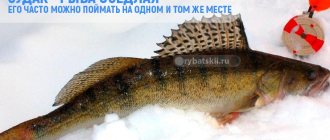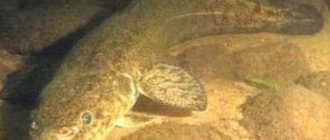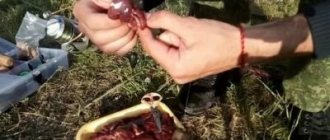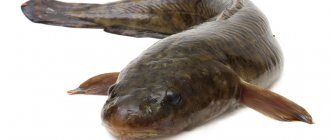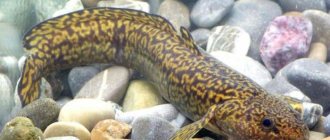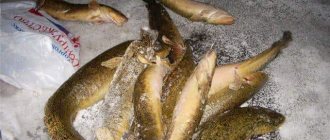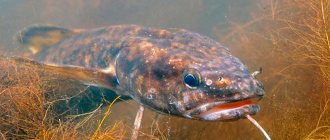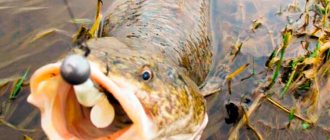Catching burbot using ice traps is a very effective method in winter. This fish is difficult to deceive with artificial bait. While when using a girder, live bait or animal bait is used. Burbot will not be able to refuse such bait, which significantly increases the likelihood of a successful bite.
Burbot willingly takes live bait in winter
Equipment for burbot girders - standard supplies, pokes, flags
To catch burbot in winter, you can use different types of live bait gear. They differ in the composition of elements. However, the operating principle of such devices is the same. Most often, fishermen use supplies, pokes, and anti-freeze girders. It is also permissible to use flag bets and bells.
Standard vent
Kolobashka
When hunting for burbot, girders with a bite alarm are mainly used. They have a plastic platform and a small spool. In the daytime, such devices can be used on pike or pike perch, and at night - on burbot.
Girdles with a bite alarm are also suitable for night fishing for burbot from the ice.
The equipment for burbot fishing poles is almost no different from how it is done when fishing for pike. The main difference lies in the leash. To protect the fishing line from the sharp teeth of the pike, you should use a hard metal leash. At the same time, for catching burbot, the leash is made of fishing line.
A rigid leash is used only if there is a chance of catching a pike. For burbot, girders and supplies are used, which are based on the following:
- line reserve – 15-20 meters;
- fishing line thickness – 0.4-1 mm;
- sinker weight – up to 100-150 grams;
- Leash length – 0.5 meters.
Equipment options for fishing poles for winter fishing
Hooks can be different. Depending on the preferences of the fisherman, either doubles or tees are used.
Threading live bait onto a double is a common option when catching burbot on girders and stands.
Since fish often do not give up a deep-swallowed hook, pulling it into the stomach, it is recommended to prepare several leashes.
Fishing technique
It is worth considering that the bite alarm may not always work, so you need to check all the girders without exception. Do not try to remove the hook from a caught burbot; cut it without regret, as the fish usually swallows its prey deeply.
Unlike another nocturnal predator - pike, burbot does not flutter and allows itself to be pulled out of the water. The fact is that the pike, having grabbed the bait, immediately tries to go away with it, but the burbot has a completely different behavioral tactic - it methodically eats up the offering in the place where it found it.
If in the morning a fisherman discovers a tightly frozen fishing line, it should be carefully freed from the ice crust using a pick. Under no circumstances should you tear or pull the fishing line, as the tackle will most likely be damaged.
If out of 10-15 girders only 1-2 worked, then it is better to place the rest closer to them, but maintaining an acceptable distance. Perhaps the fisherman simply incorrectly calculated the route of the burbot, catching only one of its points.
This will increase your chances of getting lucky again. By the way, it is better to remember the route determined by trial and error for next winter.
Burbot habitats
To properly install the girders, you need to pay attention to choosing a place for the upcoming fishing.
The most difficult moment in preparing for winter fishing is determining the routes of the fish. She sticks to certain habits and doesn't change them. If a burbot has chosen a certain path, it almost never deviates from it. Experienced fishermen begin to calculate routes in the summer.
To independently determine the movement pattern of this fish, it is worth studying information regarding underwater currents and features of the bottom topography. Burbot often chooses the confluence of small rivers or springs located underground. They are characterized by a hard bottom that does not have silt.
At the same time, the key criterion that should be taken into account when determining the movement pattern of this fish is water transparency. It is not found in polluted water bodies. Burbots also often live in areas of sharp cliffs, near capes or at the exits of bays.
Burbot sites on the river
Where and when to look for burbot
You can and should catch burbot from the ice all winter long, until the ice begins to melt, but when fishing on large rivers, you should know that the closer to the end of winter, the further the burbot goes to deep places.
Initially, you should look for burbot near the shores and beaches, on sharp drops to depth. If the coastline has a cape or curvature, this is also a good signal to search for burbot here.
It is best to start your search by placing several girders at potential burbot sites, at depths from 7 to 15 meters. Use a fish finder to correctly determine the depth. You shouldn’t hope that he will show you the fish better, but this can also happen when you find really large specimens.
Fishing for burbot in autumn and spring from the shore - video reviews from professional burbot fishermen.
Pike perch is often caught as bycatch when fishing for burbot; for more details, see the guide to catching pike perch with live bait.
Pike for fishing in winter - the right tackle, choice of live bait and search for a fishing spot.
Comments
I catch burbot at the Cheboksary hydroelectric station (below the ban), the tackle is the same as described above, the bait is king prawn, a worm can be used separately or together (sandwich). We first remove the shell from the shrimp (required). It does not take the shell, only the king shrimp does not take the other.
Vasily, I fish for simple shrimp and for ruffe, he also catches his head well, catches it and goes ahead
I catch burbot in the Murmansk region in exactly the same way as described above, but from the cut I use frozen herring bought in a store, it takes very well and on a worm in January the bite is really not the best, but if I get to its parking lot from one place in a day you can catch up to 5-9 burbot on the snitch and I put wires around it, I go around every half hour if it’s empty, I make several hits on the bottom with a sinker, that also helps
Any live bait will do, but do you need dead fish? Note to the author - live bait cannot be a dead fish!
Burbot is taken not only at depth, but also in shallows from 1 m to 2 m
I fished on the Yenisei Ridge, using ordinary beef stew as bait... I used any tackle where there was a decent size hook. mainly in shallow water (up to 1 m)…
Every year in the winter I put out 10-15 pieces of ruffs, and not because there is nothing to eat, it’s just that in the office the work in front of the computer is sedentary, and so I have to go and check, I check twice a week when I put a small live ruff on the lower lip less often, the ruff lives for a week without problems. The depth is 1-2 meters sand, in February March the burbot goes to the current and 3-4 meters, in severe frosts and sudden changes I go out to knock it when it’s -30, they say that at this time there is no bite, spawning, I don’t agree, there’s a difference between December and February I didn’t see the idea that it was not spawning in unison, I couldn’t find any other explanation, for checking 3-4-5 burbot from 1-3.5 kg. On average, a kilo, one and a half, two, basics. fishing line 0.6 Klinskaya sinker must be blind 80 gr. carabiner, leash 0.35. any hook with a long shank, I don’t take it up to a kilogram, I don’t let it go, there are small ones that sometimes ruin them and swallow them too much, but I came up with a plastic tube and now among small losses there is no such pleasure, multiply 15 holes by the thickness of the ice, you get a figure that will grow weekly so think about it first on a permanent basis. Bashkiria, Ufa, Belaya River, I fish within the city limits. During the season, a stable 45-50 burbot, 10-15 chub, 5 pike-perch are caught.
Secrets of catching burbot on the river using girders and rigs
In winter, it is best to catch burbot using live bait, and therefore live fish should be used as bait - small gobies, ruffs, roach, smelt, gudgeons.
Okushok is not as good a live bait as ruffe, but it is much easier to catch, and this is often much more important
If the fisherman does not have such live bait, you can use other small fish. It is important to ensure that the bait is fresh. The burbot will most likely refuse the spoiled bait.
After collecting gear and choosing a fishing location, you can proceed directly to the process.
There is no specific layout of the vents. They are usually placed in a promising area in a checkerboard pattern. We close the area, installing the vents at a distance of 8-12 meters from each other.
If you plan to leave the gear on all night, you need to sprinkle it with a little snow so that the rigs do not freeze.
If the fisherman is going to keep the process under control, the gear needs to be checked at intervals of 1-1.5 hours. In general, this predator has a certain activity time. In most reservoirs there are 2 time intervals. The first occurs at 9-12 pm, the second is observed in the morning - from 3 to 5.
Types of supplies
If you use a delivery option without a signaling flag, then to determine the bite, just pull the fishing line. When the tackle moves freely, it is not recommended to touch it. The presence of resistance indicates that the fish is hooked.
After the first fish has been caught, the location of the girders can be adjusted. They are shifted closer to the operating point.
When catching burbot from ice, it is most often possible to catch individuals weighing several kilograms. Large fish can be found in remote reservoirs that have impressive depth.
Fishing for burbot in winter on girders - video tips and practice:
Catching burbot in bodies of water without a current is much easier. In this case, it is important to focus on the depth of the fish’s habitat. Before spawning, the predator is easier to find in shallow water; after it is completed, it moves to other places.
Promising burbot places
If we are talking about an unfamiliar body of water, then the question is very serious. To find a promising place you will have to work hard. At the same time, you need to know for sure whether burbot is found in this reservoir or is not here, and then all searches will be in vain.
Firstly, you need to drill several dozen holes, using a certain scheme, depending on the nature of the reservoir. The more girders, the greater the chances of finding the burbot’s dispersal site. At the same time, it is necessary to take into account the fact that in these regions there is a legal limit on the use of girders. To avoid conflict with the law, every fisherman should know these rules.
If one of the gears worked, it means that this fish is in this place. At the same time, there is no point in installing gear on holes where there are no bites. If a burbot trail is discovered, this will ensure the capture of several individuals at once, and then over the next days you can expect good results in terms of catching burbot. The outcome of fishing mainly depends on how well the place for fishing is chosen. It is impossible to do without measuring the depths, so you will have to spend some of the precious time on this procedure. But first you need to make holes. The hole from the hole can be located at a distance of 10 to 20 meters. Their number can be at least 10, and they can be arranged in a checkerboard pattern. This approach is relevant when the body of water is unfamiliar. As for a familiar body of water, every angler knows all the differences in depth, holes, edges, drops, etc.
Burbot prefers to stay in deep places, and with warming it moves even deeper and this factor should be taken into account. This process is especially active at the end of winter. In winter, when it is very cold, burbot can be found in areas where the depth is shallow. These can be gently sloping shores, beaches, shallows that turn into dumps.
If a burbot site is discovered, we can safely say that fishing is guaranteed for the entire season. The main thing is to demonstrate desire and patience, which will then result in productive fishing.
It should be noted, in conclusion, that burbot is a unique fish. This can be said to be the only type of fish that is not caught in the summer, but shows maximum activity in the dead of winter. In addition, it spawns in fairly cold water, which is not possible for any species of fish found in our rivers. This factor has a positive effect on the survival of burbot. The appearance of eggs is unlikely to awaken the appetite of most predators, which show minimal activity in winter.
Source
Fishing time and weather conditions
The behavior of burbot differs from other fish. The worse the weather conditions, the better the bite. The lower the air temperature, the more snow or the stronger the wind, the greater the catch is possible. Of course, not every fisherman is ready to go to a reservoir in inclement weather. If he decides to do this, an excellent catch is guaranteed.
Burbot remains active throughout the winter; it is most actively caught on girders in December and January. A bad bite is possible only during the spawning period, which occurs in February. This pause lasts approximately 2 weeks. During the spawning period, burbot does not eat, but it can beat fry that are nearby.
If the fry turns out to be a live bait fish, the predatory fish will not fail to feast on it.
Catching burbot on burbots at night in November-December is considered the best option; during this period of winter the predator bites best.
Adviсe
Features of hooking and fishing
It is recommended to catch burbot passively, since the fish catches itself, deeply drawing in the bait. To do this, you need to arrange the gear, and then from time to time go around it and pull out the fish. Often the zherlitsa are left overnight. They need to be checked in the morning.
When using poles with flags, it is worth considering that a predator can peck very carefully, swallowing live bait while standing at one point. That's why alarms often don't go off.
How to position and drill holes
To install the girders, you need to make a series of holes in the ice. They are placed in a straight line, zigzag, staggered, or in an arc. The scheme should be chosen taking into account the fish sites. The bottom topography is of no small importance.
Night VS day
Burbot is characterized by a nocturnal lifestyle. During the daytime he is mostly passive. Therefore, it is quite rare to catch fish during the day. She bites at night or late in the evening.
However, the specific timing directly depends on the weather. In some cases, the fish bite all day long.
When using girders, it is possible to achieve better results. They are installed at night - when the predator goes hunting.
Strategy for moving through an unfamiliar body of water
Fishermen who come to the reservoir for the first time need to find the routes along which the burbot moves. To do this, it is necessary to make holes at different points and install the supports as widely as possible.
After the first bites, you can concentrate the gear in a certain place. This strategy is considered quite dynamic. It involves constant movement on the ice.
How to catch burbot in winter on a girder (how to catch, preserve and bait live bait in a reservoir, collecting and equipping supplies):
Zherlitsy
Probably the easiest way to catch burbot is with girders. Usually they are installed in the evening, and in the morning they check the gear and take the catch. To equip the girder, a fishing line with a cross section of 0.45-0.5 mm is used. Its quantity on the reel depends on the depth of the reservoir. Advice! You should not wind a lot of fishing line on the reel of the fishing rod. This will not allow the fish to go into snags or stones. A sufficient length is equal to the depth of the place being fished plus 1 m. The leash is set with a thickness of 0.25-0.28 mm. It is advisable to tie it to the main line through a swivel to avoid tangling of the equipment. A triple or double live bait hook, at least size 10, is placed at the end of the leash. Advice! It is better to take leashes for girders from durable materials, such as steel or braided cord. It is these that will be difficult for burbot to snack on. A sliding sinker weighing up to 15 grams is attached in front of the leash. Small live bait is used as bait for girders. It should be baited behind the back, so it will remain mobile longer and will be able to attract more fish. To remove trophy specimens from the hole, every fisherman needs to have a hook in his arsenal.
Favorite live bait
For burbot fishing to be successful, it is recommended to pay attention to the choice of live bait. The most suitable options include:
- Loach is the favorite food of burbot. However, it can be quite difficult to obtain it, especially in winter. In winter, the loach is not caught with a fishing rod. To catch fish, you can use lift traps. They are lowered to the bottom and air bubbles are supplied by a compressor, which attract the attention of the fish.
- Ruff – Desired prey for predatory fish and burbot in particular. At the same time, catching this fish in winter is much easier. The ruff is considered quite tenacious. Therefore, it retains its attractiveness to burbot for a long time.
Ruff is the best live bait for zherlits - Perches and gobies - these fish also attract burbot. They can be safely used as bait.
Catching burbot on rigs in the winter is a promising fishing method, although a little boring compared to fishing for pike and large perch on rigs.
What do you use to catch burbot in winter?
Since burbot is a predator, its menu includes food of animal origin. The following baits are suitable for catching it:
- Live bait;
- Dead fish;
- Pieces of fish;
- Crawling out.
Burbot is best caught using live bait, and this is not surprising, since small fish are part of its daily diet. Other types of baits are less effective and only work in those reservoirs where there is a large population of burbot. This mainly applies to artificial baits. When using crawlers, you should take into account that other types of fish, including peaceful ones, also love them. Dead fish are just as attractive to burbot as are pieces of fish and pieces of meat, but the most catchy bait is live bait.
Small specimens of the following fish species can be used as live bait:
- Ruff;
- Perch;
- Minnow, etc.
